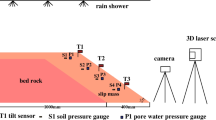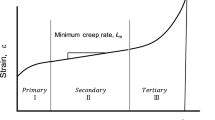Abstract
In recent decades, early warning systems using tilt sensors to predict the occurrence of landslides have been developed and employed in slope monitoring due to the simple installation and low cost of these systems. However, few studies were carried out to investigate the tilting behaviors of landslides, and the prediction methods for the occurrence of slope failure based on tilting measurements also demand detailed investigations. In this paper, pre-failure tilting behaviors of slopes were investigated by performing a series of model tests as well as a field test. The test results reveal a linear relationship between the reciprocal tilting rate and time during the acceleration stage of tilting before slope failure. Furthermore, an equation for this linear relation was also proposed. By approximating the reciprocal tilting rate to be 0/o, the slope failure time can be forecasted using the proposed equation, and the predicted failure time is consistent with the actual slope failure time recorded in this study. Additionally, the correlation between the tilting rate and remaining time before slope failure in logarithmic space was also studied, and most of the data is situated in a region with boundaries. Based on this region, it is possible to anticipate the remaining time before slope failure at an arbitrary tilting rate in the acceleration stage. Conclusively, this paper provides comprehensive investigations on the correlation between the pre-failure tilting behaviors and duration time before landslides, and also introduces a method to potentially predict the occurrence of slope failure based on the slope tilting measurement.






















Similar content being viewed by others
References
Angeli MG, Pasuto A, Silvano S (2000) A critical review of landslide monitoring experiences. Eng Geol 55(3):133–147
Carlà T, Intrieri E, Di TF, Nolesini T, Gigli G, Casagli N (2017) Guidelines on the use of inverse velocity method as a tool for setting alarm thresholds and forecasting landslides and structure collapses. Landslides 14(2):517–534
Dikshit A, Satyam DN, Towhata I (2018) Early warning system using tilt sensors in Chibo, Kalimpong, Darjeeling Himalayas, India. Nat Hazards 94(2):727–741
Dixon N, Smith A, Flint JA, Khanna R, Clark B, Andjelkovic M (2018) An acoustic emission landslide early warning system for communities in low-income and middle-income countries. Landslides 15(8):1631–1644
Federico A, Popescu M, Murianni A (2015) Temporal prediction of landslide occurrence: a possibility or a challenge? Italian J Eng Geol Environ 1:41–60
Fukuzono T (1985) A new method for predicting the failure time of a slope. Proc. IV, international conference and field workshop on landslides, Tokyo, pp 145-150
García A, Hördt A, Fabian M (2010) Landslide monitoring with high resolution tilt measurements at the Dollendorfer Hardt landslide, Germany. Geomorphology 120(1–2):16–25
Hao SW, Liu C, Lu CS, Elsworth D (2016) A relation to predict the failure of materials and potential application to volcanic eruptions and landslides. Sci Rep 6(27877):1–7
Intrieri E, Gigli G (2016) Landslide forecasting and factors influencing predictability. Nat Hazards Earth Syst Sci 16:2501–2510
Intrieri E, Gigli G, Mugnai F, Fanti R, Casagli N (2012) Design and implementation of a landslide early warning system. Eng Geol 147(148):124–136
Intrieri E, Carlà T, Gigli G (2019) Forecasting the time of failure of landslides at slope-scale: a literature review. Earth Sci Rev 193:333–349
Ishihara Y, Kobatake S (1979). Run off model of flood forecasting. Bulletin of the Disaster Prevention Research Institute, Kyoto University, 29: 27–43
Keefer DK, Wilson RC, Mark RK, Brabb EE, Brown W, Ellen SD, Harp EL, Wieczorek GF, Alger CS, Zatkin RS (1987) Real-time landslide warning during heavy rainfall. Science 238:921–925
Koerner RM, McCabe WM, Lord AE (1981) Acoustic emission behaviour and monitoring of soils. In acoustic emission in geotechnical practice. ASTM STP 750:93–141
Kuramoto K, Noro T, Osanai N, Kobayashi M, Okada K (2005). A study on rainfall indexes for giving early warning information for sediment-related disasters. Proceedings of annual research meeting in 2005, Japan Society of Erosion Control Engineering, pp 186-187 (in Japanese)
Manconi A, Giordan D (2016) Landslide failure forecast in near-real-time. Geomat Nat Haz Risk 7(2):639–648
Mufundirwa A, Fujii Y, Kodama J (2010) A new practical method for prediction of geomechanical failure-time. Int J Rock Mech Min Sci 47(7):1079–1090
Okada K (2001). Soil water index Sokko-Jiho. Japan Meteorological Agency 69-567-100 (in Japanese)
Okamoto T, Larsen JO, Matsuura S, Asano S, Takeuchi Y, Grande L (2004) Displacement properties of landslide masses at the initiation of failure in quick clay deposits and the effects of meteorological and hydrological factors. Eng Geol 72:233–251
Osanai N, Shimizu T, Kuramoto K, Kojima S, Noro T (2010) Japanese early-warning for debris flows and slope failure using rainfall indices with radial basis function network. Landslides 7(3):325–338
Petley DN (2012) Global patterns of loss of life from landslides. Geology 40:927–930
Petley DN, Bulmer MH, Murphy W (2002) Patterns of movement in rotational and translational landslides. Geology 30(8):719–722
Petley DN, Mantovani F, Bulmer MH, Zannoni A (2005) The use of surface monitoring data for the interpretation of landslide movement patterns. Geomorphology 66:133–147
Rouse C, Styles P, Wilson SA (1991) Microseismic emissions from flowslide-type movements in South Wales. Eng Geol 31(1):91–110
Saito M (1969). Forecasting time of slope failure by tertiary creep, in: Proceedings of 7th international conference on soil mechanics and foundations engineering. Montreal, Canada, Pergamon Press, Oxford, Great Britian, pp 667–683
Saito M (1987) On application of creep curves to forecast the time of slope failure. J Jpn Landslide Soc 24:30–38
Smethurst JA, Smith A, Uhlemann S, Wooff C, Chambers J, Hughes P, Lenart S, Saroglou H, Springman SM, Löfroth H, Hughes D (2017) Current and future role of instrumentation and monitoring in the performance of transport infrastructure slopes. Q J Eng Geol Hydrogeol 50:271–286
Smith A, Dixon N, Meldrum P, Haslam E, Chambers J (2014) Acoustic emission monitoring of a soil slope: comparisons with continuous deformation measurements. Géotechnique Lett 4:255–261
Towhata I, Uchimura T, Gallage CPK (2005). On early detection and warning against rainfall-induced landslide. Proc. of the first general assembly and the fourth session of Board of Representatives of the international consortium on landslides (ICL), springer, Washington, DC, pp 133–139
Uchimura T, Towhata I, Trinh TLA, Fukuda J, Carlos JBB, Wang L, Seko I, Uchida T, Matsuoka A, Ito Y, Onda Y, Iwagami S, Kim MS, Sakai N (2010) Simple monitoring method for precaution of landslides watching tilting and water contents on slopes surface. Landslides 7(3):351–357
Uchimura T, Towhata I, Wang L, Nishie S, Yamaguchi H, Seko I, Qiao J (2015) Precaution and early warning of surface failure of slopes by using tilt sensors. Soil Foundation 55(5):1086–1099
Voight B (1988) A method for prediction of volcanic eruptions. Nature 332:125–130
Voight B (1989) A relation to describe rate-dependent material failure. Science 243:200–203
Xie JR, Uchimura T, Chen P, Liu JP, Xie CR, Shen Q (2019) A relationship between displacement and tilting angle of the slope surface in shallow landslides. Landslides 16(6):1243–1251
Zhang FY, Huang XW (2018) Trend and spatiotemporal distribution of fatal landslides triggered by non-seismic effects in China. Landslides 15(8):1663–1674
Acknowledgements
This research was supported by Chinese Scholarship Council (CSC,Grant No.201506370052) for PhD studies of the first author, and the Grants-in-Aid for Scientific Research of the Japan Society for the Promotion of Science (JSPS), Core-to-Core Program B (No. 16H04407).
Author information
Authors and Affiliations
Corresponding author
Appendix
Appendix
-
1)
The method for the calculation of tilting rates
In this study, the data series for analyzing were selected with an interval of 1° in the accelerating stage before slope failure considering the influence of noises as well as the fluctuation of the monitoring data which is close to 1o. As shown in Fig. 23, the tilting rate can be approximated using the following equation
Where tij and tij − 1 represent time, and dθ means the increment of tilting angles during the periord from tij − 1 to tij, in this study, dθ = 1°. \( {\left(\frac{d\theta}{d t}\right)}_{ij} \) is the tilting rate at time tij.
Then the reciprocal tilting rate can be expressed as
Rights and permissions
About this article
Cite this article
Xie, J., Uchimura, T., Wang, G. et al. A new prediction method for the occurrence of landslides based on the time history of tilting of the slope surface. Landslides 17, 301–312 (2020). https://doi.org/10.1007/s10346-019-01283-8
Received:
Accepted:
Published:
Issue Date:
DOI: https://doi.org/10.1007/s10346-019-01283-8





